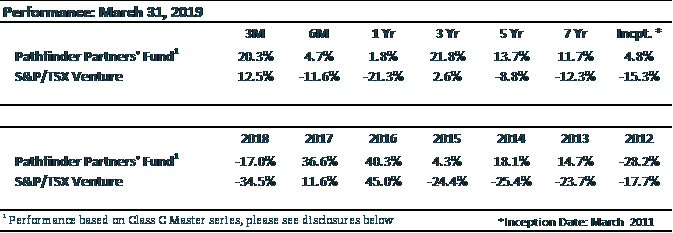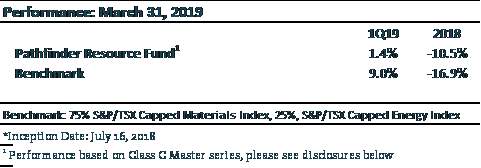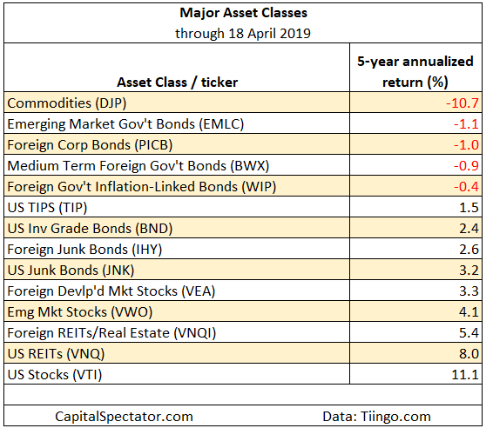Pathfinder Small Cap. Quarterly Report
MARCH 31, 2019
The Pathfinder Small Cap mandates invest in high-torque, early-stage companies that have the potential to generate superior returns.
Pathfinder Partners’ Fund
After a difficult fourth quarter, the Partners’ Fund rebounded, rising 20.6% net in the first quarter of 2019. This compares to the TSX Venture Exchange which returned 12.5%. Our annualized 5-year return is 13.7% net compared to the TSX Venture Exchange’s return of -8.8% per year over the same period. The table below provides a performance summary:

During the quarter, our two largest contributors were Xebec Adsorption Inc (TSXv:XBC) and Cardiol Therapeutics Inc. (TSXv:CRDL), which added 6.9% and 4.9% respectively to gross returns. Both of these companies ended the quarter having risen approximately 10x from our initial purchase price. The only holding which contributed more than a 0.5% decline to gross portfolio returns was Exro Technologies Inc (CSE:XRO) which caused a 0.7% decline.
While it is tempting to attribute performance in any given quarter to recent investment activity, the reality is that our returns in any given quarter are usually a function of investments we made years ago. We first invested in Xebec in 2016 and purchased Cardiol in early 2017. Our investment style involves getting involved in early stage, overlooked companies and waiting for them to advance their business plan and become appreciated by the market.
During the quarter, we initiated a position in Redline Communications Group Inc (TSX:RDL). Redline is in the communications business – they develop private networks for remote and challenging environments. Their revenues declined several years ago due to heavy exposure to the Oil & Gas industry, but the company has successfully stabilized their business, diversified its customer base, and begun to grow the top line again. We purchased our fractional ownership interest at what we think is a bargain price. Redline holds substantial current assets, more than all the combined liabilities and market capitalization of the company at our purchase price. In addition to the downside protection of their assets, Redline has a high margin, recurring revenue stream that we believe would be attractive to multiple potential acquirers. There has recently been a shakeup in the management team and board ownership, suggesting to us that strategic alternatives may be considered, hopefully generating a strong return to our investment.
We noticed continued positive developments in the eSports (competitive video games) space during the quarter. While there is an increasing amount of media and hype surrounding the sector, we prefer to focus on tangible, quantitative metrics such as viewership, prize money, and advertising dollars spent when tracking the progress of the sector. During the quarter, we continued to increase our eSports weighting, but at a more gradual pace and more selectively, with increasingly stringent investment criteria. Our assessment of the sector is that market participants are now aware that eSports represents a potential promising investment area. This differs from when we made our initial eSports investments in late 2016 and early 2017; at that point nobody was talking about eSports. In the stock market, everything runs in cycles, and there is a time to be planting new seeds (making investments) and a time to be harvesting (selling); eSports is a perfect example. We seek to invest in overlooked sectors that have the potential to become the next hot space, while avoiding too much exposure to the flavor of the day. As eSports continues to gain popularity, we anticipate higher valuations and lower quality opportunities, and we will be reducing our purchase activity in that sector commensurately.
In terms of assessing the blue sky potential of eSports, we would like to make a comparison to one of the major themes in the stock market over the last decade, Social Media. We have seen the dramatic value creation and evolution of Social Media starting with Facebook, then transitioning to Instagram and then to Snapchat, as each new generation of users begins to participate. We have also seen specialized social networks targeting subsets of the population, such as Pinterest, where 81% of users are reported to be females. While by no means a certainty, we see the potential possibility of eSports and video games evolving into a type of ‘Social Network’. Given the amount of time that boys and young men spend playing video games, there is significant earnings potential and value creation that could possibly occur if this were to happen.
Pathfinder Resource Fund
During the quarter, the Resource fund rose 1.4%. This compares to the benchmark return of 9.0%. Since inception (July 16, 2018), the Resource Fund has declined by 9.2% versus the benchmark which declined by 9.6%. The benchmark consists of 75% of the daily return of the S&P/TSX Capped Materials Index and 25% of the daily return of the S&P/TSX Capped Energy Index.

The Resource Fund is structured so that half of the fund is in 10-12 ‘Core’ positions. These are larger, more liquid companies with strong management and developed resources. The other half of the fund is in a series of smaller ‘Starter’ positions in junior companies with market capitalization of less than $100 million. During the quarter, we had strong performance from the Core portfolio holdings, while the early-stage Starter positions brought losses. Our best performers were Adventus Zinc Corporation (TSXv:ADZN), Altius Resources (TSX:ALS), and Equinox Gold (TSX:EQX); each added between 1.1% and 1.2% to gross portfolio returns. Our largest detractor was Diamcor Mining Inc (TSXv:DMI), which decreased gross returns by 1.6%.
This type of performance is to be expected. The junior mining sector is driven by sentiment, commodity price, and discovery. We should expect the junior miners to have a tough time in a depressed commodity environment, absent any discoveries. However, we expect superior returns on the early-stage companies when the sector goes through an up-cycle, aided by warrants we have accumulated on the vast majority of positions. In contrast, our Core holdings have established assets which are tangible and provide downside protection and/or a potential lower bound on valuation. We are in a unique point in the resource cycle where there is little capital available, and we can get access to the very best management teams in the business at attractive valuations. This opportunity is rare and we hope to continue to take advantage of it by deploying additional capital into the space.
We created the Resource Fund to take advantage of the prolonged bear market in mining, energy, and other resource companies. Commodities are a cyclical business and eventually low prices will incent demand, reduce production, and set the stage for higher prices and a bull market. We recently came across a table that illustrates the underperformance in commodities, and hopefully highlights the value proposition in investing in Resource Equities.

As you can see, US stocks returned over 10% per year for the last 5 years while commodities (defined by the Bloomberg Commodity Index Total Return ETN) lost over 10% per year for the last 5 years. This divergence illustrates the downturn in commodities and in our opinion, represents the opportunity we have in the Resource space.
In our last quarterly, we highlighted two developments as illustrative examples that we are in the bottoming phase of a resource cycle. The first was a large mining fund giving up on the sector; they changed their strategy and advisors, going from 100% mining to only 25% mining and 75% infrastructure. The second was the series of large mergers in the gold space, first between Barrick & Randgold and then between Goldcorp and Newmont. We are hopeful that these mergers will lead to increased efficiency and capital discipline in the sector, setting the stage for improved shareholder returns as the next commodity cycle begins.
During the first quarter, we don’t have any reportable sources to point towards ‘signs of bottoming’, but anecdotally, there has been much chatter in the industry about the high turnover rate of fund managers in the mining space and strategic decisions from some funds to divest from exploration and development companies, focusing exclusively on producers. This is typical capitulation behavior that occurs in a cyclical downturn.
Currently, the fund is heavily weighted to gold and copper. However, there is no shortage of other resources for us to monitor for potential investment. Throughout the year, we hope to deepen our understanding of several commodities including Frac Sand, Lumber and Battery Metals such as graphite and lithium. Each of these spaces is in a downturn and will at some point represent an attractive investment opportunity. We continue to monitor these sectors and watch for the telltale signs of the bottoming of a cycle such as bankruptcies and capacity shutdowns.
National Instrument 31-103 requires registered firms to disclose information that a reasonable investor would expect to know, including any material conflicts with the firm or its representatives. Doug Johnson and/or Pathfinder Asset Management Limited are an insider of companies periodically mentioned in this report. Please visit www.paml.ca for disclosures.
* All returns are time weighted and net of investment management fees. Returns from the Partners’ Fund are presented based on the Class C Master series except prior to its inception in July 2011 when the Class A Master series was used. Inception returns include the 10 months from inception in March 2011. Returns greater than one year are annualized. Returns from the Resource Fund are presented based on the Class C Master series since its inception in July 16, 2018. The S&P/TSX Venture Composite Index (C$), the S&P/TSX Venture Composite Index, the S&P/TSX Capped Materials Index and the S&P/TSX Capped Energy Index provide general information and should not be interpreted as a benchmark for your own portfolio return. Further details of the Partners’ Fund are available on request.
Pathfinder Asset Management Limited (PAML) and its affiliates may collectively beneficially own in excess of 10% of one or more classes of the issued and outstanding equity securities mentioned in this newsletter. This publication is intended only to convey information. It is not to be construed as an investment guide or as an offer or solicitation of an offer to buy or sell any of the securities mentioned in it. The author is an employee of PAML, but the data selection, analysis and views expressed herein are solely those of the author and not those of PAML. The author has taken all usual and reasonable precautions to determine that the information contained in this publication has been obtained from sources believed to be reliable and that the procedures used to summarize and analyze such information are based on approved practices and principles in the investment industry. However, the market forces underlying investment value are subject to sudden and dramatic changes and data availability varies from one moment to the next. Consequently, neither the author nor PAML can make any warranty as to the accuracy or completeness of information, analysis or views contained in this publication or their usefulness or suitability in any particular circumstance. You should not undertake any investment or portfolio assessment or other transaction on the basis of this publication, but should first consult your portfolio manager, who can assess all relevant particulars of any proposed investment or transaction. PAML and the author accept no liability of any kind whatsoever or any damages or losses incurred by you as a result of reliance upon or use of this publication.